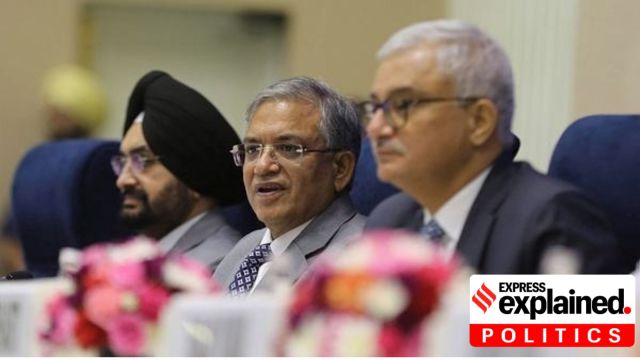The EC takes the decision to schedule the elections – when and in how many phases – after taking into account several factors, including the logistics, the weather and other elections that may be due.

What is the present situation in Bihar?
Under the Constitution, the Lok Sabha and Vidhan Sabhas have a five-year term, and the elections to elect a new legislature should be completed before the end of that term. The EC prepares for the elections to a state Assembly or the Lok Sabha well in advance, given that the last date of the term is known five years in advance.
The Assembly elections in Bihar were due before the end of the term of the present Assembly on November 22. The EC announced the schedule on October 6, with polling in two phases on November 6 and November 11, and counting of votes on November 14.
The polling will be held in 121 Assembly constituencies in phase one and 122 seats in phase two.
The number of phases has reduced from three in 2020, five in 2015, six in 2010, and four in 2005. The EC has also increased the number of security personnel deployed this time.
What factors does the EC consider when scheduling an election?
The EC accounts for other elections due around the same time, to club these together. It also takes into account factors like weather conditions, as well as festivals, holidays and school examinations.
Story continues below this ad
“The Election Commission, which decides the schedule for elections, has to take account of the weather – during winter, constituencies may be snow-bound, and during the monsoon, access to remote areas restricted, – the agricultural cycle, so that the planting or harvesting of crops is not disrupted, – exam schedules, as schools are used as polling stations and teachers employed as election officials, and religious festivals and public holidays. On top of this, there are the logistical difficulties that go with holding an election – sending out ballot boxes, setting up polling booths, recruiting officials to oversee the elections,” former CEC M S Gill wrote in “The Electoral System of India”.
The EC also accounts for the number of security forces needed to ensure a secure election free of violence. The forces are moved across states during the multiple phases of a Lok Sabha election. For states affected by Left-Wing Extremism or facing other security concerns, a higher number of security personnel is required, splitting the polling into multiple phases.
No other polls have been slated during the Bihar Assembly elections, allowing the EC to keep the election period short. When asked about the reasons for this, Chief Election Commissioner Gyanesh Kumar said on October 6: “Voter awareness, availability of CAPFs (Central Armed Police Forces), the assessment of law and order and the enhancement in the capacity of the EC and its officials – looking at all these factors, it was felt appropriate to conduct the elections in two phases.”
How have polls been scheduled in the past?
Starting from the very first general elections in 1951, the scheduling of polling has been very carefully planned. The first Chief Election Commissioner of India, Sukumar Sen, wrote in his report on the 1951-52 elections that the “polling dates were fixed with due regard to the preparations made, and the climatic and geographical conditions in the various states”.
Story continues below this ad
Polling in Independent India’s first-ever election started in October 1951 with two Assembly constituencies of Himachal Pradesh, Chini and Pangi, intending to complete these before snowfall that usually started in early-November, he wrote. Polls for the rest of the state unfolded in November. Similarly, two Parliamentary constituencies of Travancore-Cochin (present-day Kerala) had polls before the rest of the state. Polling in Odisha, Madhya Pradesh, Hyderabad and Punjab started in December 1951, while in the rest of the states, it started in January 1952.
The scheduling of the Bihar polls caused controversy in 1995, with the CEC T N Seshan facing off against Chief Minister Lalu Prasad Yadav. Seshan undertook the task of cleaning up the campaign at a time when booth-capturing and violence were prevalent, and was forced to postpone the elections four times as violence broke out.
In 2024, then-CEC Rajiv Kumar acknowledged that the 2024 Lok Sabha elections, which unfolded in seven phases, had gone on longer than they should have, and that they should have ended at least a month earlier, instead of stretching into the summer. “We cannot reduce the time taken for the process, but it could have been done earlier instead of in such heat,” he said.







































